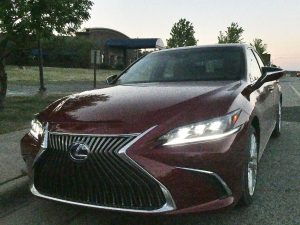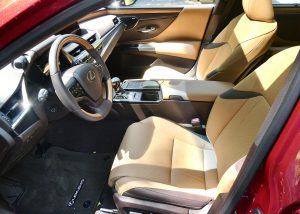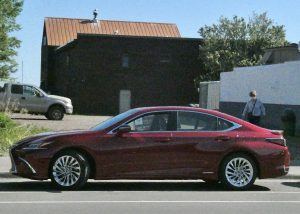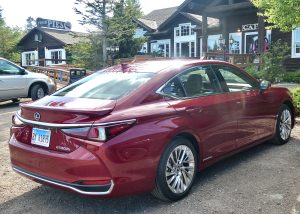Lexus ES300h goes its own way — smoothly
By John Gilbert
It’s become ingrained among auto critics to call cars built by Toyota “boring” and likening them to appliances,” which meant the Lexus luxury line models were probably “stylish appliances.” It’s going to take some adjusting, but those days have passed. When you examine the technical upswing of the 2020 models, it’s obvious those long-suffering cocoons have released a whole range of butterflies.
Toyota is such a huge company, with factories all around the world, building vehicles that were so trouble-free, the company reached the point of satisfaction. Everything Toyota built was basically bullet-proof as far as breakdowns were concerned, with strong, durable engines that would easily top 200,000 miles while housed in solid, safe vehicles.
Years slipped by, and competitors kept improving, but finally, a young man named Akio Toyoda became president of Toyota Motor Company. He is the grandson of Kiichiro Toyoda, the founder of Toyota Motors, but Akio is different. At age 64, he enjoyed sports and racing high-performance vehicles. And he determined that the boring title would be rendered to the scrap-heap, even if his company’s cars never seemed to suffer that fate.
He sent some new model designs back to the drawing board, demanding sportier exteriors to accompany the resurgence back to the cutting edge of technology it had seemed to abandon, while Honda, Mazda, Nissan, and South Korean newcomers Hyundai and Kia went right on by. Without a doubt, the new Camry, Corolla, RAV-4, and other models, and their accompanying ad campaigns, indicate new recipes are boiling up on the menu.
The 2020 Lexus ES 300, for example, had always been a stretched Camry with bling, but the new car I got for a test drive was not just any ES 300. It was an ES 300h Ultra Luxury, where the “h” stands for hybrid, and which shows that the Japanese may still need to bring their naming concepts up to the car’s new edge. This 300h is a long, low, slinky luxury liner, so “Ultra Luxury” is not inappropriate, if comparatively trite.
As you approach the car, the bold, sporty-car grille, sporting a new Lexus signature look, and blends into 6-headlight LED beams, and then that long, sensuous body. The grille itself, with its intricate fanning out of metal struts could probably hypnotize you if you stared at it long enough. It was placed on a new platform of its own one year ago, meaning the 2019 model got a head start on other Toyota and Lexus models making their way upward to new levels of stiffness and sophistication.
And while Toyota rules the world of hybrids with its ever-expanding Prius models, Toyota’s “Hybrid Synergy Drive” has spent a decade using nickel-metal-hydride battery packs, but the test car has “Lexus Hybrid Drive” includes a slick Lithium Ion battery pack that sits low and flat under the rear seat to leave extra room in the rear seat and the trunk.
With a new platform and an appealing body, the ES 300 gets a new powertrain, with a 2.5-liter 4-cylinder gasoline engine coupled to that electric system. Together, they provide 215 horsepower, a commendable blend of power and fuel economy. It’s one of those perception things — drive it, and use the paddle shifters on the beautifully designed steering wheel, and you will declare that the power is easily adequate for hauling your family around.
With front-wheel drive, the ES 300h handles with quick precision, and you also get a dashboard switch that allows you to click from Eco to Normal to Sport. Yes, paddle shifters and a Sport setting, encouraging you to add sporty driving to the mix, in a Lexus luxury sedan.
The transmission is an electronically controlled CVT (continuously variable transmission), but the paddles allow you to shift it as though you’re using real gears on the other end of that cable. All working in concert, the car established EPA fuel economy estimates of 43 city and 44 highway. We didn’t get out on the open roads enough, but we kept track and the computer indicated we got 42 miles per gallon in overall driving for a week.
New platform, new engine, new hybrid system, new controllable CVT transmission, perfectly tuned suspension, and all the proper electronic devices to prevent lane departure and sloppy parallel parking, and the rest of the attention can go to making sure the ES 300h lives up to its luxury heritage. Remember, this car began life as a fancy Camry for the Lexus line, and has now taken wing on its own.
The aniline-leather bucket seats are stunning when you first open the door, and the fine fabrics and trim of everything inside is just as impressive as you settle into that bucket seat. On the Ultra Luxury model — which boosts the base ES sticker from $45,660 to a still-reasonable $55,560 — the 17-inch alloy wheels are replaced by 18-inchers. The 2.0 Pre-collision warning system is in place, and there are countless other features that help you go, steer, and remain stable.
A dynamic handling suspension, radar cruise, lane-departure alert and lane-tracing assist, plus steering assist if you are too sleepy to stay centered in your lane are nice additions. There are 10 airbags scattered about the cabin, and an intuitive parking assist for parallel-parking-challenged drivers. The intelligent high-beam system has road-sign assist to alert you to the number you just overlooked, on the dash and on the head-up display.
The head-up display is enlarged to 10.2 inches, and the color display for multimedia is enlarged from 8.0 inches to 12.3 inches on the Ultra Luxury.
The basic sound system is probably real good, with 10 speakers and all, but the test car had been upgraded to the Mark Levinson surround system with 1,800 watts of power blowing your tunes through 17 different speakers, and simple duties like changing the station on your satellite radio system was complex enough that you should let your wife or chosen passenger bucket occupant play with it while you spend about a month getting acclimated.
Driving on the hillsides of Duluth, Minnesota, it was handy to use those paddles to direct the transmission to help contain your power going downhill, and we probably would have gotten better fuel economy if we weren’t enjoying using the paddles to extract sporty performance and uphill acceleration quite so much. We got just over 40 miles per gallon, but decided the EPA estimates of 43 city and 44 highway would be reachable with a lighter right foot.
Lexus doesn’t hesitate to wave some of its features in your face, either. The outside mirrors, for example, are “Electrochromatic Heated Outside Mirrors,” and the front-seat buckets are “14-way aniline leather driver’s seat, with the passenger seat 10-way power.”
With the “Triple-Beam LED headlights” and stylish taillights announcing whether you’re coming or going, if anyone refers to the Lexus ES 300h as an appliance, then my question is how can I get Toyota to build my refrigerator?







 John Gilbert is a lifetime Minnesotan and career journalist, specializing in cars and sports during and since spending 30 years at the Minneapolis Tribune, now the Star Tribune. More recently, he has continued translating the high-tech world of autos and sharing his passionate insights as a freelance writer/photographer/broadcaster. A member of the prestigious North American Car and Truck of the Year jury since 1993. John can be heard Monday-Friday from 9-11am on 610 KDAL(www.kdal610.com) on the "John Gilbert Show," and writes a column in the Duluth Reader.
John Gilbert is a lifetime Minnesotan and career journalist, specializing in cars and sports during and since spending 30 years at the Minneapolis Tribune, now the Star Tribune. More recently, he has continued translating the high-tech world of autos and sharing his passionate insights as a freelance writer/photographer/broadcaster. A member of the prestigious North American Car and Truck of the Year jury since 1993. John can be heard Monday-Friday from 9-11am on 610 KDAL(www.kdal610.com) on the "John Gilbert Show," and writes a column in the Duluth Reader.